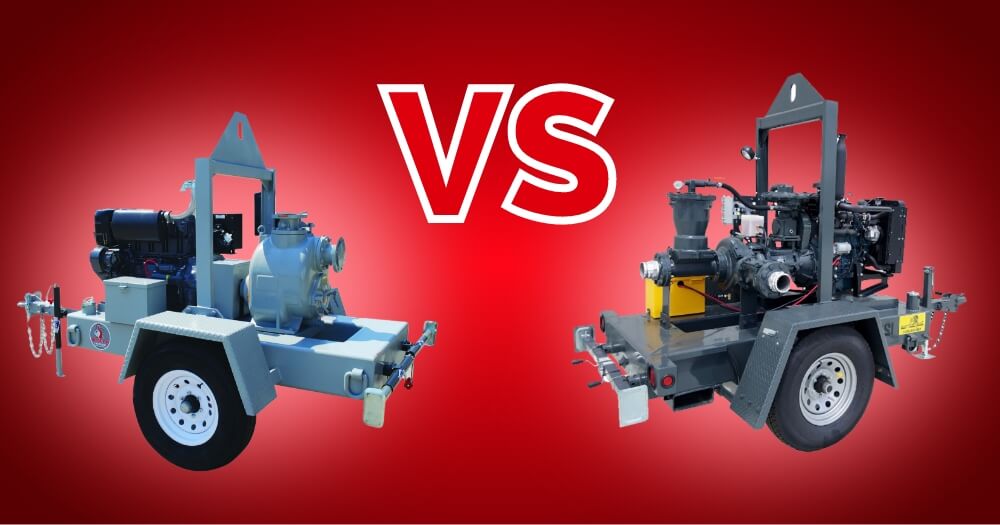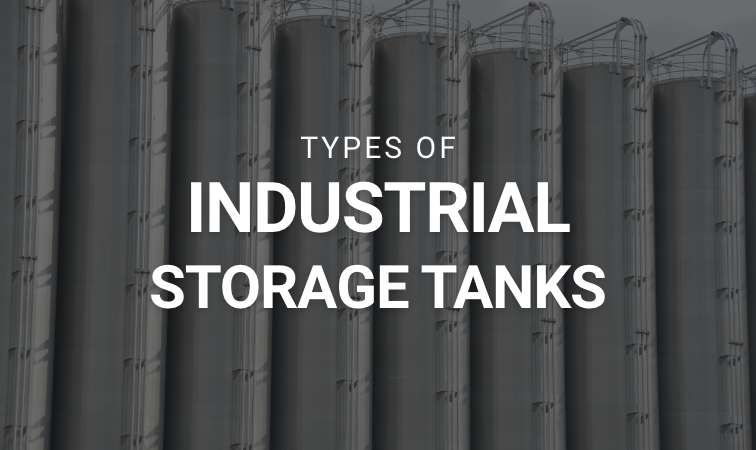29 Apr Positive Displacement Pump vs. Centrifugal Pump: Choosing the Right Pump for Your Needs
Choosing the right pump for the job is a major consideration for any operation. To help you decide which type of pump is right for your purposes, we created this article, which discusses the nuances between two fundamental types – positive displacement pumps vs. centrifugal pumps. By exploring how these pumps operate, their distinctive applications and their key differences, we aim to provide insights that will guide you in selecting the best pump for your needs.

What Is a Centrifugal Pump?
The simplest response to the question, "What is a centrifugal pump?" is that a centrifugal pump harnesses the power of kinetic energy to move fluids. No doubt your next question is, "How does a centrifugal pump work?" At the heart of its operation is a rotating impeller, which accelerates the fluid outward from the pump's center to its periphery, thereby converting kinetic energy to pressure energy. This mechanism makes centrifugal pumps highly effective for transferring large volumes of liquid in several applications.
Industries That Use Centrifugal Pumps
Centrifugal pumps are versatile and widely used across various industries due to their capability to handle large volumes of fluids, their efficiency with low-viscosity liquids and their relatively simple maintenance requirements.
Here are examples of industries that typically use centrifugal pumps:
- Water Treatment and Distribution: These pumps are essential in water treatment plants for moving water through filtration systems and in municipal systems for water distribution due to their ability to handle large volumes efficiently.
- Chemical Industry: Centrifugal pumps transfer chemicals, solvents and other low-viscosity fluids. Their design allows for handling corrosive or hazardous materials with appropriate material selection.
- Oil and Gas: These pumps facilitate the transfer of water, crude oil and other fluids in upstream and downstream operations, including refining processes where large volumes of liquids need to be moved.
- Power Generation: In power plants, centrifugal pumps are used for boiler feed water, cooling systems and condensate extraction, among other applications.
- Agriculture and Irrigation: These pumps are used extensively for irrigation, helping to distribute water over large agricultural fields efficiently.
- Food and Beverage: While a positive displacement pump is often preferred for its ability to handle viscous fluids, a centrifugal pump is used for transferring water and other low-viscosity fluids within these industries.
- Pharmaceuticals: Centrifugal pumps are used to transfer water and various liquid ingredients in the manufacturing of pharmaceuticals, where hygiene and contamination control are crucial.
- Marine and Shipbuilding: For ballast control, cooling systems and firefighting, centrifugal pumps are a common choice due to their capacity to move large volumes of water.
- Heating, Ventilation and Air Conditioning (HVAC): Centrifugal pumps play a critical role in HVAC systems, circulating hot or cold water throughout the system to maintain the desired temperature conditions within buildings.
Each industry selects centrifugal pumps based on specific requirements like flow rate, pressure and fluid characteristics, ensuring optimal performance and efficiency.
What Is a Positive Displacement Pump?
Now, let's shift gears and discuss our second type of industrial pump. "What is a positive displacement pump?" These pumps operate on a principle fundamentally different from their centrifugal counterparts. Positive displacement pumps move fluid by enclosing a fixed volume, utilizing mechanical means to transfer that volume from the inlet to the discharge side of the pump. This method ensures a consistent flow regardless of the pressure conditions, making positive displacement pumps particularly suitable for applications requiring precise volume management. How does a positive displacement pump work? Through the repeated cycle of trapping fluid and forcing it through the discharge pipe, these pumps excel in handling viscous fluids or those containing suspended solids. Their ability to maintain efficiency across many viscosities and pressures underscores their versatility and reliability in specialized applications.
Industries That Use a Positive Displacement Pump
Positive displacement pumps, known for their ability to handle viscous fluids and maintain a consistent flow rate regardless of pressure, find applications across several industries. Their unique operational characteristics make them suitable for tasks where precision, handling complex fluids or working under varying pressure conditions is essential. Here are examples of industries that frequently use positive displacement pumps:
- Oil and Gas: For the transfer of crude oil, drilling muds and other viscous fluids, a positive displacement pump is invaluable. It's also used in dosing additives and chemicals with precision.
- Chemical Manufacturing: These pumps are chosen for their ability to handle aggressive, corrosive and high-viscosity chemicals accurately and safely.
- Food and Beverage: Positive displacement pumps are preferred to gently handle shear-sensitive products like sauces, yogurts and beverages. They maintain the integrity of the product during processing and packaging.
- Pharmaceuticals: The ability to precisely dose and handle fluids of varying viscosities without contamination is crucial in the pharmaceutical industry, making positive displacement pumps a preferred choice.
- Cosmetics: For the production of creams, lotions and gels, a positive displacement pump offers the required precision and gentle handling to maintain product quality.
- Pulp and Paper: These pumps transfer viscous slurries, inks and dyes, ensuring the consistent flow rates necessary for production processes.
- Wastewater Treatment: Positive displacement pumps are used for sludge handling, dosing treatment chemicals and other applications where varying viscosity and solid content are common.
- Maritime: On ships and in dockyards, these pumps are used for fuel transfer, bilge pumping and managing waste efficiently and reliably.
- Mining: In the mining industry, positive displacement pumps are employed for dosing chemicals used in processing minerals, as well as for pumping slurries with high solid content.
- Agriculture: Positive displacement pumps are used for precise irrigation, fertigation and pesticide application, ensuring the right amount of fluid is delivered where needed.
The choice of pump type — gear, lobe, piston or others — depends on the specific requirements of the application, including fluid characteristics, required pressure and flow rate.

The Difference Between a Positive Displacement Pump and a Centrifugal Pump
Understanding the difference between a positive displacement pump and a centrifugal pump is crucial. The primary distinction lies in the operation: Centrifugal pumps add velocity to fluids, converting kinetic energy into flow and pressure, while positive displacement pumps move a fixed volume of fluid, offering a consistent flow regardless of pressure changes. This fundamental difference affects their efficiency, application and maintenance needs:
1. Efficiency
Centrifugal pumps are more efficient for high flow, low viscosity applications, whereas positive displacement pumps excel in handling viscous fluids with high efficiency at lower flow rates.
2. Applications
Centrifugal pumps are ideal for water, wastewater and other low-viscosity fluids. Positive displacement pumps are preferred for viscous fluids or when precise dosing or high pressure is required.
3. Maintenance Requirements
Centrifugal pumps typically have lower maintenance needs due to fewer moving parts, while positive displacement pumps may require more regular upkeep due to their complex mechanisms.
The difference between a positive displacement pump and a centrifugal pump can also be observed in the following aspects:
- Flow Rate vs. Pressure: Centrifugal pumps experience a decrease in flow rate as pressure increases, unlike positive displacement pumps, which deliver a constant flow rate.
- Shear Sensitivity: Positive displacement pumps are better suited for shear-sensitive fluids, as centrifugal pumps can cause fluid degradation.
- Cost Implications: Initial and operating costs can vary significantly and be influenced by the specific application and operational conditions.
Understanding these differences is crucial for making an informed decision tailored to the specific requirements of your operation, ensuring efficiency, reliability and cost-effectiveness.
Positive Displacement Pump vs. Centrifugal Pump: Frequently Asked Questions
Understanding the complexities of a positive displacement pump vs. a centrifugal pump can raise numerous questions, especially when determining the best fit for specific applications. Below, we address some of the most common inquiries. Please contact us with any other questions you may have.
Are Positive Displacement Pumps Generally Less Efficient Than Centrifugal Pumps?
You may be wondering which pump has maximum efficiency. In a nutshell, efficiency in pumps is not a one-size-fits-all metric. While centrifugal pumps may be more efficient for moving low-viscosity fluids in high-flow scenarios, positive displacement pumps excel in efficiently transferring viscous fluids at lower flow rates.
Which Pump Requires the Least Maintenance?
Centrifugal pumps generally require less maintenance due to their simpler design and fewer moving parts. However, the specific maintenance needs can vary based on the application environment and operational conditions.
Can Positive Displacement Pumps Handle Solids?
Many positive displacement pumps are designed to handle fluids with suspended solids. Their operation allows for the movement of such fluids without significant degradation, making them ideal for applications in the wastewater treatment and food industries.
How Do I Choose Between a Centrifugal Pump vs. a Positive Displacement Pump?
Choosing between these pump types depends on several factors, including the fluid viscosity, required flow rate, pressure conditions and whether the fluid contains solids. It's also important to consider the total cost of ownership, including initial costs, maintenance and operation efficiency.
Positive Displacement Pump or Centrifugal Pump, Dragon Products Has What You Need
Selecting the right positive displacement pump or centrifugal pump for your operation is easier when you partner with Dragon Products. Because we have over 50 years of expertise in manufacturing high-quality, reliable equipment, you can feel confident in whichever type of pump you choose – we carry transfer pumps, too. Our commitment to quality and our in-house manufacturing process means that every pump we offer is built to the highest standards, ready to tackle the challenges of your specific industrial needs. Contact us today!
GET AN EQUIPMENT QUOTEPumps and Stimulation | Dragon Products
Dragon offers comprehensive solutions and support across all shale plays, featuring robust frac pumps, blending units and water transfer systems, all backed by our advanced data control technologies.






Sorry, the comment form is closed at this time.